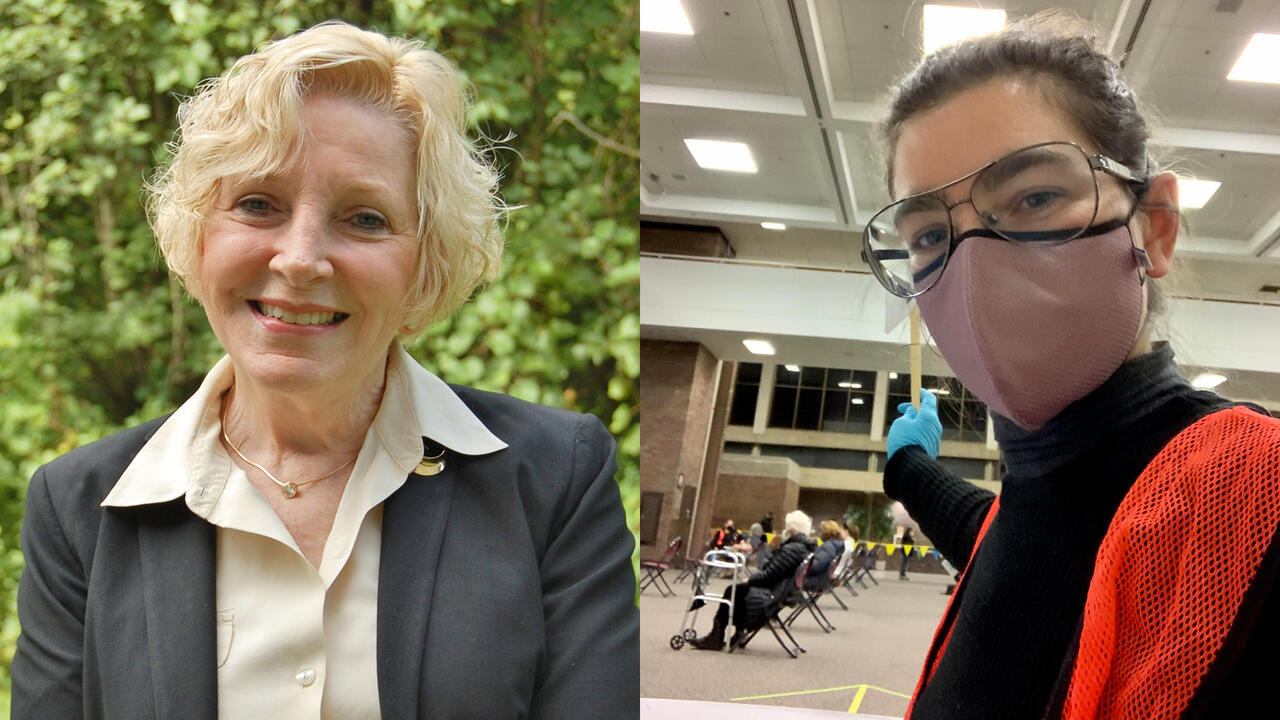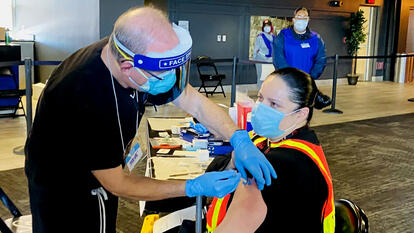Alumnae Work to Develop Vaccines, Trace COVID-19 Outbreaks

Dr. Lisa Dunkle ’68, an infectious disease specialist, and Lauren Fink ’10, an epidemiologist, are both working to combat the COVID-19 pandemic. They also share the experience of watching a mysterious virus convulse the world early in their professional lives.
Dunkle, who earned her medical degree at Johns Hopkins four years after graduating from Wellesley, began her industry career in clinical drug development at the height of the HIV/AIDS epidemic. “It was trial by fire,” she said. “In retrospect I can say that I didn’t develop the best drugs that have come along, but I developed some of the first ones.” Dunkle spent years in drug development and retired from her position as chief medical officer at the vaccine company Protein Sciences in December 2019. Then the pandemic struck.
While she homeschooled her grandchildren, she wondered about what she could do to help. “I knew from the very beginning of the pandemic, when people started talking about vaccines, that the two companies that had the right technology to do this were Protein Sciences and Novavax,” she said. When the latter reached out to her in the summer of 2020 with a job offer, “I said to my husband, ‘I can’t not do this.’ This is what I have been preparing for for 45 years. I can’t turn my back on it. And everybody, including my husband, my kids, my grandkids who are old enough to understand, they all thought this was great. Grandma was going to take care of the world.”
Dunkle is now vice president of clinical development and global medical lead for Novavax’s COVID-19 vaccine, running the trial funded by Operation Warp Speed (OWS) in the U.S. and Mexico. The company recently completed its phase 3 trial in the U.K., demonstrating over 89 percent efficacy—but, Dunkle said, OWS is “the big one,” with 30,000 participants. She anticipates that the vaccine will be available later in the spring. “Just a guess, but it’s based on a lot of experience,” she said calmly. “And I feel like I will have done my job.”
She predicts it will be another six to eight months before life in the United States quickens its pace again. “I think the virus will continue to evolve. I do think it’s likely to become endemic, which means it’s just always out there,” she said. “And periodically, you get little outbreaks, but most people will be immune. We may have to come up with a vaccine that changes on some kind of a regular basis,” like the influenza vaccine. “Thanks be to God, this is easy to do with the molecular technologies we have today,” she added, noting that investigators are building on decades of research.
“It will take time, and things will likely get worse before they get better, but I really do feel confident that we have the tools to beat this thing.”
Lauren Fink ’10
Dunkle intends to receive the Novavax vaccine when it becomes available.
In the meantime, she is working as hard as she ever has. “My first year at Wellesley, at convocation, someone said that prayer, ‘of those to whom much has been given, much is expected.’ That just went straight to my heart,” she said. “If you’ve been given a lot, you better sure as hell give it back. And I realized that that’s what we’re here for.”
The pandemic also sent Fink’s career in a new direction. Trained in global health and epidemiology, with a master’s in public health from Emory University, she worked on issues like lead poisoning and air pollution until early last year. But as the virus took hold in the U.S., she was in Detroit working in what she called “the greatest boot camp in epidemiologic methods that anyone could have ever designed.”
“I went from having never done infectious disease investigation before in real life to helping lead a team that was doing high-risk facility investigations, and then leading that team myself,” she said.
She recalled thinking that “if we just work hard enough and sleep little enough—you know, just trace the heck out of these people—maybe we’re gonna beat it.” But, she said, “at some point very quickly, it became clear that it was everywhere. We were just very late in responding.” In addition, in terms of responding to the pandemic effectively, Fink said “the public health infrastructure in the U.S. is just not where it needs to be.”
Fink began her COVID-19 work tracing outbreaks in nursing homes, and she currently works with schools and day cares at a large county health department, deciding who should be quarantined and finding possible exposures that school administrators might have overlooked. After nearly a year, her enthusiasm remains undimmed. “There is this other side to epidemiology that’s very interpersonal,” she said. “I hadn’t had any experience with it before. And now that’s what I do all day, and I love it—even though I’m talking to people during really difficult times.”
She is both relieved and amazed that effective vaccines are in production. Noting that much more investment and coordination are needed for distribution, Fink is also focused on education. “I think that’s a big way we can combat vaccine hesitancy,” she said. “Instead of oversimplifying the science, we make it understandable. People are capable of processing robust information if it is presented clearly.”
Fink, who is on the board of a small Reconstructionist shul, helped to run an outdoor vaccine clinic for surrounding neighborhoods on the last Friday in January. “As members of our community get vaccinated, I recall the Shehecheyanu prayer expressing gratitude that we could reach this moment in time. My heart hurts thinking about the inequities surrounding the vaccine distribution process, in the U.S. and globally,” she said. “But on optimistic days, I think about how we live at a time where scientists can develop, test, and start distributing a vaccine for a novel virus in less than a year. It will take time, and things will likely get worse before they get better, but I really do feel confident that we have the tools to beat this thing.”
This is the second in a two-part series looking into how Wellesley alumnae are involved in the rollout of the COVID-19 vaccine. Read the first story here.

